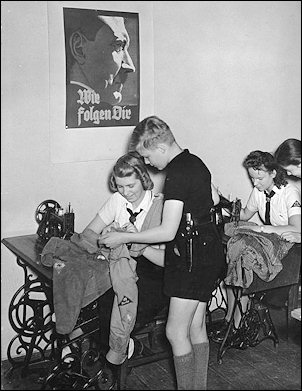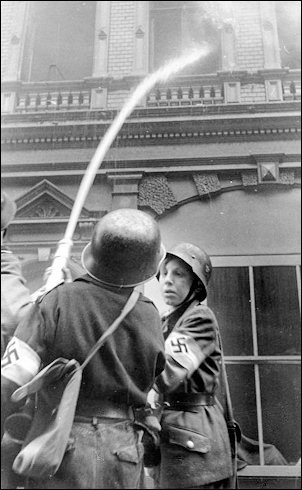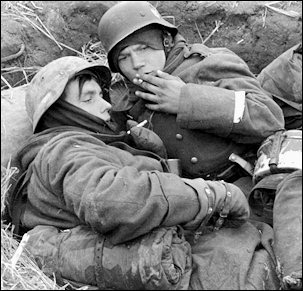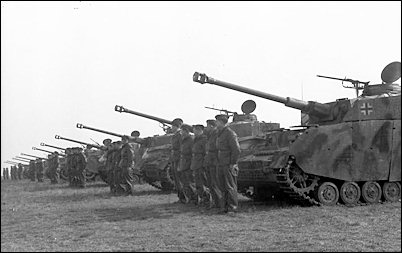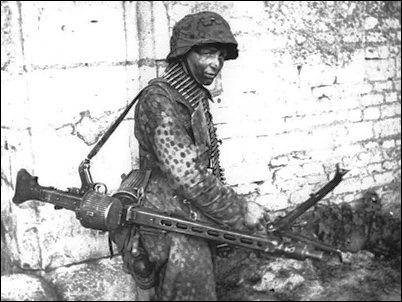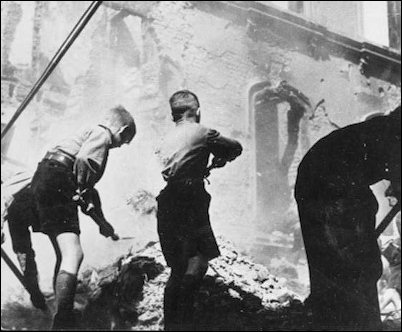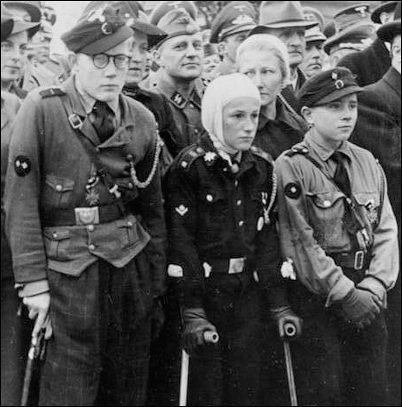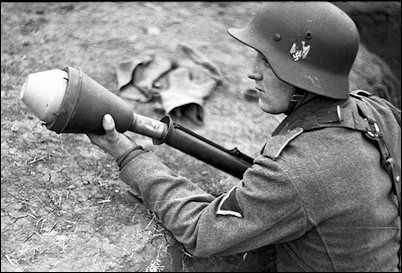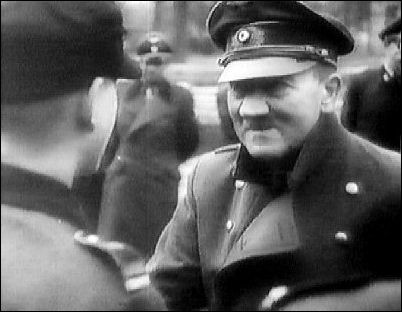![]()

Hitler's Boy Soldiers
1939 - 1945
On September 1st, 1939, Hitler's armies invaded Poland. Six years of war would follow with the full participation of the Hitler Youth eventually down to the youngest child.
At the onset of war, the Hitler Youth totaled 8.8 million. But the war brought immediate, drastic changes as over a million Hitler Youth leaders of draft age and regional adult leaders were immediately called up into the army.
This resulted in a severe shortage of local and district leaders. The problem was resolved by lowering the age of local Hitler Youth leaders to 16 and 17. The average age had been 24. These 16 and 17-year-olds would now be responsible for as many as 500 or more boys. Another big change was the elimination of the strict division between the Jungvolk (boys 10 to 14) and the actual HJ (Hitler Youth 14 to 18).
The HJ organization had sprawled into a giant bureaucracy with 14 different regional offices. It was now cut back to just six main offices. Hitler Youth Leader Baldur von Schirach, not wanting to be left out of the war, received Hitler's permission to volunteer for the army. He underwent training and received a rapid rise through the ranks, becoming a lieutenant in just a few months. He was replaced by Artur Axmann, who had headed the HJ Social Affairs Department and had been involved with the organization since the late 1920s.
The war returned a sense of urgency to the daily activities of the Hitler Youth. The organization had experienced a bit of a slump after 1936 when participation had become mandatory. For many young Germans, weekly HJ meetings and required activities had simply become a dreary routine. The original mission of the HJ had been to bring Hitler to power. Victory in the war became the new mission and HJ boys enthusiastically sprang into action, serving as special postmen delivering draft notices in their neighborhoods along with the new monthly ration cards. They also went door to door collecting scrap metals and other needed war materials.
BDM - Girls
Girls also enthusiastically participated, although they were assigned limited duties in keeping with the Nazi viewpoint on the role of females. An old German slogan, popular even during the Nazi era, summed it up – Kinder, Kirche, Küche (Children, Church, Kitchen). The primary role of young females in Nazi Germany was to give birth to healthy, racially pure (according to Nazi standards) boys. All women's organizations were thus regarded as auxiliaries ranking below their male counterparts.
BDM girls were assigned to help care for wounded soldiers in hospitals, to help in kindergartens, and to assist households with large families. They also stood on railway platforms, offering encouragement and refreshments to army troops departing for the front.
Following the rapid German victory over Poland, girls from the Land Service were assigned to the acquired territory in northern Poland (Warthegau) to assist in the massive Nazi repopulation program in which native Poles were forced off their homes and farms by Himmler's SS troops to make way for ethnic Germans. Hitler Youths also assisted in this operation by watching over Polish families as they were evicted from their homes, making sure they took only a few basic possessions. Everything else of value was to be left behind for the Germans.
Hitler considered the war in the East to be a "war of annihilation" in which those considered racially inferior, the Slavs and Jews, would be forcibly resettled or destroyed. Masses of unwanted humanity were thus forced into the southeastern portion of Poland where ghettos sprang up along with slave labor camps and eventually the extermination camps.
Following the Nazi invasion of the Soviet Union, ethnic Germans began arriving into the Warthegau from areas of Russia and Eastern Europe. Hitler Youths were utilized to help resettle and Nazify the new arrivals, many of whom did not even speak German. Children of the arrivals were also subject to mandatory participation in the HJ.
Flak Gun Crews
In August 1940, British air raids began against Berlin in retaliation for the German bombing of London. Hitler Youth boys had already been functioning as air raid wardens and anti-aircraft (flak) gun assistants in Berlin and other cities since the outbreak of war, and now saw their first action.
The first thousand-bomber raid occurred in May 1942 against Cologne. In that same month, newly created Wehrertüchtigungslager or WELS (Defense Strengthening Camps) went into operation in Germany providing three weeks of mandatory war training for all boys aged 16 to 18 under the supervision of the Wehrmacht. They learned how to handle German infantry weapons including various pistols, machine-guns, hand grenades and Panzerfausts (German bazookas).
By the beginning of 1943, Hitler's armies were stretched to the limit, battling the combined forces of Soviet Russia, United States, Britain and other Allies. By this time, most able-bodied German men were in the armed services. As a result, starting on January 26, 1943, anti-aircraft batteries were officially manned solely by Hitler Youth boys.
At first they were stationed at flak guns near their homes, but as the overall situation deteriorated, they were transferred all over Germany. The younger boys were assigned to operate search lights and assist with communications, often riding their bicycles as dispatch riders. In October 1943, a search light battery received a direct bomb hit, killing the entire crew of boys, all aged 14 and under.
Following each bombing raid, Hitler Youths assisted in neighborhood cleanup and helped relocate bombed out civilians. They knocked on doors looking for unused rooms in undamaged houses or apartments. Occupants refusing to let in the new 'tenants' were reported to the local police and could likely expect a visit from Gestapo.
KLV Camps
America's entry into the war in December of 1941 had resulted in a massive influx of air power into England. As the Allies stepped up their bombing campaign, the Nazis began evacuating children from threatened cities into Hitler Youth KLV (Kinderlandverschickung) camps located mainly in the rural regions of East Prussia, the Warthegau section of occupied Poland, Upper Silesia, and Slovakia.
From 1940 to 1945, about 2.8 million German children were sent to these camps. There were separate KLV camps for boys and girls. Some 5,000 camps were eventually in operation, varying greatly in sizes from the smallest which had 18 children to the largest which held 1,200. Each camp was run by a Nazi approved teacher and a Hitler Youth squad leader. The camps replaced big city grammar schools, most of which were closed due to the bombing. Reluctant parents were forced to send their children away to the camps.
Life inside the boys' camp was harsh, featuring a dreary routine of roll calls, paramilitary field exercises, hikes, marches, recitation of Nazi slogans and propaganda, along with endless singing of Hitler Youth songs and Nazi anthems. School work was neglected while supreme emphasis was placed on the boys learning to automatically snap-to attention at any time of the day or night and to obey all orders unconditionally "without any if or buts."
Isolated in these camps and without any counter-balancing influences from a normal home life, the boys descended into a primitive, survival of the fittest mentality. Weakness was despised. Civilized notions of generosity and sympathy for those in need faded. Rigid pecking orders arose in which the youngest and most vulnerable boys were bullied, humiliated, and otherwise made to suffer, including repeated sexual abuse.
Total War - The 12th SS-Panzer Division Hitlerjugend
1943 marked the military turning point for Hitler's Reich. In January, the German Sixth Army was destroyed by the Russians at Stalingrad. In May, the last German strongholds in North Africa fell to the Allies. In July, the massive German counter-attack against the Russians at Kursk failed. The Allies invaded Italy. An Allied invasion of northern Europe was anticipated.
The war could only end with the "unconditional surrender" of Germany and its Axis partners, as stated by President Franklin Roosevelt at the Casablanca Conference in January 1943. In February, Nazi Propaganda Minister Joseph Goebbels retaliated by issuing a German declaration of "Total War."
Amid a dwindling supply of manpower, the existence of an entire generation of ideologically pure boys, raised as Nazis, eager to fight for the Fatherland and even die for the Führer, could not be ignored. The result was the formation of the 12th SS-Panzer Division Hitlerjugend.
A recruitment drive began, drawing principally on 17-year-old volunteers, but younger members 16 and under eagerly joined. During July and August 1943, some 10,000 recruits arrived at the training camp in Beverloo, Belgium.
To fill out the HJ Division with enough experienced soldiers and officers, Waffen-SS survivors from the Russian Front, including members of the elite Leibstandarte-SS Adolf Hitler, were brought in. Fifty officers from the Wehrmacht, who were former Hitler Youth leaders, were also reassigned to the division. The remaining shortage of squad and section leaders was filled with Hitler Youth members who had demonstrated leadership aptitude during HJ paramilitary training exercises. The division was placed under of the command of 34-year-old Major General Fritz Witt, who had also been a Hitler Youth, dating back before 1933.
Among his young troops, morale was high. Traditional, stiff German codes of conduct between officers and soldiers were replaced by more informal relationships in which young soldiers were often given the reasons behind orders. Unnecessary drills, such as goose-step marching were eliminated. Lessons learned on the Russian Front were applied during training to emphasize realistic battlefield conditions, including the use of live ammunition.
By the spring of 1944, training was complete. The HJ Panzer Division, now fully trained and equipped, conducted divisional maneuvers observed by General Heinz Guderian and Field Marshal Gerd von Rundstedt, both of whom admired the enthusiasm and expressed their high approval of the proficiency achieved by the young troops in such a short time. The division was then transferred to Hasselt, Belgium, in anticipation of D-Day, the Allied invasion of northern France. A few days before the invasion, SS-Reichsführer Heinrich Himmler visited the division.
On D-Day, June 6th, 1944, the HJ Division was one of three Panzer divisions held in reserve by Hitler as the Allies stormed the beaches at Normandy beginning at dawn. At 2:30 in the afternoon, the HJ Division was released and sent to Caen, located not far inland from Sword and Juno beaches on which British and Canadian troops had landed. The division soon came under heavy strafing attacks from Allied fighter bombers, which delayed arrival there until 10 p.m.
The HJ were off to face an enemy that now had overwhelming air superiority and would soon have nearly unlimited artillery support. The Allies, for their part, were about to have their first encounter with Hitler's fanatical boy-soldiers.
The shocking fanaticism and reckless bravery of the Hitler Youth in battle astounded the British and Canadians who fought them. They sprang like wolves against tanks. If they were encircled or outnumbered, they fought-on until there were no survivors. Young boys, years away from their first shave, had to be shot dead by Allied soldiers, old enough, in some cases, to be their fathers. The "fearless, cruel, domineering" youth Hitler had wanted had now come of age and arrived on the battlefield with utter contempt for danger and little regard for their own lives. This soon resulted in the near destruction of the entire division.
By the end of its first month in battle, 60 percent of the HJ Division was knocked out of action, with 20 percent killed and the rest wounded and missing. Divisional Commander Witt was killed by a direct hit on his headquarters from a British warship. Command then passed to Kurt Meyer, nicknamed 'Panzermeyer,' who at age 33, became the youngest divisional commander in the entire German armed forces.
After Caen fell to the British, the HJ Division was withdrawn from the Normandy Front. The once confident fresh-faced Nazi youths were now exhausted and filthy, a sight which "presented a picture of deep human misery" as described by Meyer.
In August, the Germans mounted a big counter-offensive toward Avranches, but were pushed back from the north by the British and Canadians, and by the Americans from the west, into the area around Falaise. Twenty four German divisions were trapped inside the Falaise Pocket with a narrow 20 mile gap existing as the sole avenue of escape. The HJ Division was sent to keep the northern edge of this gap open.
However, Allied air superiority and massive artillery barrages smashed the HJ as well as the Germans trapped inside the pocket. Over 5,000 armored vehicles were destroyed, with 50,000 Germans captured, while 20,000 managed to escape, including the tattered remnants of the HJ.
By September 1944, the 12th SS-Panzer Division Hitlerjugend numbered only 600 surviving young soldiers, with no tanks and no ammunition. Over 9,000 had been lost in Normandy and Falaise. The division continued to exist in name only for the duration of the war, as even younger (and still eager) volunteers were brought in along with a hodgepodge of conscripts. The division participated in the failed Battle of the Bulge (Ardennes Offensive) and was then sent to Hungary where it participated in the failed attempt to recapture Budapest. On May 8, 1945, numbering just 455 soldiers and one tank, the 12th SS-Panzer Division Hitlerjugend surrendered to the American 7th Army.
Volkssturm - The Final Defense
Hitler's own generals tried to assassinate him on July 20, 1944, to end Nazi Germany's all-out commitment to a war that was now clearly lost. But the assassination attempt failed. Hitler took revenge by purging the General Staff of anyone deemed suspicious or exhibiting defeatist behavior. Nearly 200 officers and others were killed, in some cases, slowly hanged from meat hooks.
Germany under Hitler would now fight-on to the very last, utilizing every available human and material resource. In September, Hitler Youth Leader Artur Axmann proclaimed: "As the sixth year of war begins, Adolf Hitler's youth stands prepared to fight resolutely and with dedication for the freedom of their lives and their future. We say to them: You must decide whether you want to be the last of an unworthy race despised by future generations, or whether you want to be part of a new time, marvelous beyond all imagination."
With the Waffen-SS and regular army now depleted of men, Hitler ordered Hitler Youth boys as young as fifteen to be trained as replacements and sent to the Russian Front. Everyone, both young and old, would be thrown into the final fight to stop the onslaught of "Bolshevik hordes" from the East and "Anglo-American gangsters" from the West.
On September 25, 1944, anticipating the invasion of the German Fatherland, the Volkssturm (People's Army) was formed under the overall command of Heinrich Himmler. Every available male aged 16 to 60 was conscripted into this new army and trained to use the Panzerfaust anti-tank weapon. Objections to using even younger boys were ignored.
In the Ruhr area of Germany, HJ boys practiced guerilla warfare against invading U.S. troops. In the forests, the boys stayed hidden until the tanks had passed, waiting for the foot soldiers. They would then spring up, shoot at them and throw grenades, inflicting heavy causalities, then dash away and disappear back into the forest. The Americans retaliated with furious air-attacks and leveled several villages in the surrounding area.
If the boys happened to get cornered by American patrols, they often battled until the last boy was killed rather than surrender. And the boys kept getting younger. American troops reported capturing armed 8-year-olds at Aachen in Western Germany and knocking out artillery units operated entirely by boys aged twelve and under. Girls were also used now, operating the 88mm anti-aircraft guns alongside the boys.
In February 1945, project Werewolf began, training German children as spies and saboteurs, intending to send them behind Allied lines with explosives and arsenic. But the project came to nothing as most of these would-be saboteurs were quickly captured or killed by the Allies as they advanced into the Reich.
The Russians by now were roaring toward Berlin, capitol of Nazi Germany, where Hitler had chosen to make his last stand. On April 23rd, battalions made up entirely of Hitler Youths were formed to hold the Pichelsdorf bridges by the Havel River. These bridges in Berlin were supposed to be used by General Wenck's relief army coming from the south. That army, unknown to the boys, had already been destroyed and now existed on paper only. It was one of several phantom armies being commanded by Hitler to save encircled Berlin.
At the Pichelsdorf bridges, 5,000 boys, wearing man-sized uniforms several sizes too big and helmets that flopped around on their heads, stood by with rifles and Panzerfausts, ready to oppose the Russian Army. Within five days of battle, 4,500 had been killed or wounded. In other parts of Berlin, HJ boys met similar fates. Many committed suicide rather than be taken alive by the Russians.
All over the city, every able-bodied male was pressed into the desperate final struggle. Anyone fleeing or refusing to go to the front lines was shot or hanged on the spot by SS executioners roaming the streets hunting for deserters.
In his last public appearance, just ten days before his death, Adolf Hitler ventured out of his Berlin bunker on his 56th birthday into the Chancellery garden to decorate twelve-year-old Hitler Youths with Iron Crosses for their heroism in the defense of Berlin. The extraordinary event was captured on film and remains one of the most enduring images chronicling the collapse of Hitler's thousand-year Reich, as the tottering, senile-looking Führer is seen congratulating little boys staring at him with worshipful admiration. They were then sent back out into the streets to continue the hopeless fight.
On April 30, 1945, as the Russians advanced to within a few hundred yards of his bunker, Hitler committed suicide. The next day, Hitler Youth Leader Artur Axmann, who had been commanding an HJ battalion in Berlin, abandoned his boys and fled to the Alps. In Vienna, Baldur von Schirach abandoned HJ units fighting to defend that city.
The war ended with Germany's unconditional surrender on May 7, 1945. However, it was soon realized that this defeat was unlike any other in history. In addition to his war of military conquest, Hitler had also waged a war against defenseless civilians. The events of that war, revealed in the coming months during the Nuremberg trials, would stun the world, and even resulted in a new term to describe the systematic killing of an entire race of people – genocide.
Copyright © 1999 The History Place™ All Rights Reserved
![]()
NEXT SECTION - Aftermath, Nuremberg and Beyond
The History Place - Hitler Youth Index Page
The History Place Main Page
Terms of use: Private home/school non-commercial, non-Internet re-usage only is allowed of any text, graphics, photos, audio clips, other electronic files or materials from The History Place.
